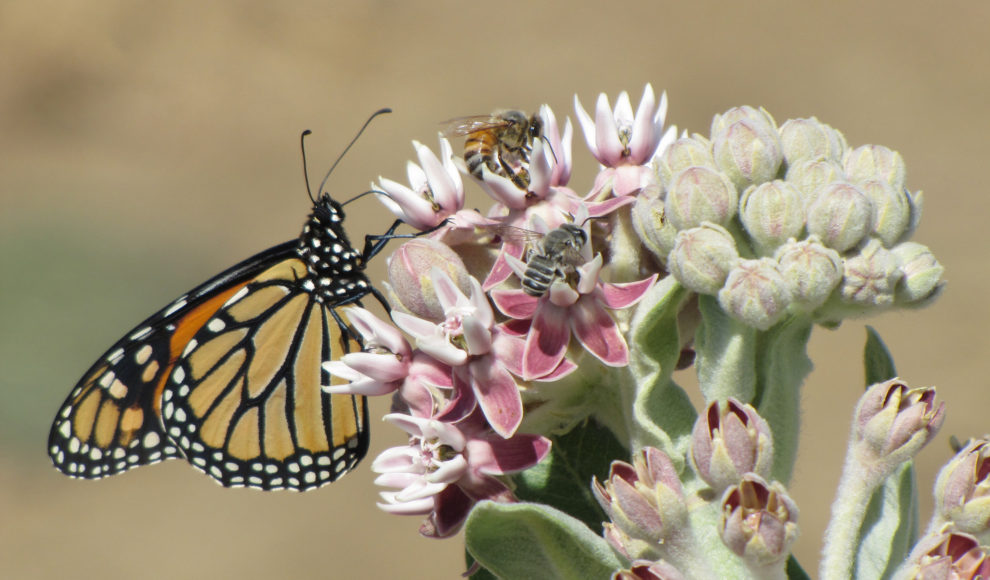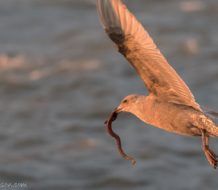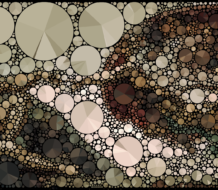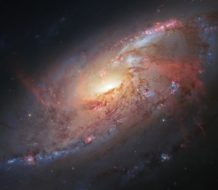Counting the number of herbivorous insect species that scientists have identified reveals a remarkable possibility: insects that feed on living plants may be the most species-rich group of organisms ever to have evolved in the history of life on the planet. This includes extinct lineages such as the Palaeodictyoptera — among the first herbivorous insects to have evolved. Only unnamed microbes might be more diverse (although this hypothesis is controversial). Parents in some future colony on Mars could someday read to their children the bedtime story The Very Hungry Caterpillar by Eric Carle and with that story illustrate the essential nature of the two most diverse life forms on our planet: herbivorous insects and flowering plants.
In fact, together, herbivorous insect species and flowering plant species account for well over half of all species on the planet. By focusing on the mechanisms driving the diversification of these two lineages — these two branches of the tree of evolutionary life — we can begin to address the broader question, “Why are there so many species of life on earth?”
This big question bedeviled biologists well before Charles Darwin and Alfred Russell Wallace co-discovered the theory of evolution by natural selection in the late 1850s, and it remains multifaceted, nuanced, and nebulous. Nevertheless, although far from having all of the answers, the field of evolutionary biology has made considerable progress toward them.
Darwin hinted at the idea that species interactions are a crucible for the evolution of new species in one of the most beautiful passages in On the Origin of Species:
It is interesting to contemplate an entangled bank, clothed with many plants of many kinds, with birds singing on the bushes, with various insects flitting about, and with worms crawling through the damp earth, and to reflect that these elaborately constructed forms, so different from each other, and dependent on each other in so complex a manner, have all been produced by laws acting around us…Thus, from the war of nature, from famine and death, the most exalted object which we are capable of conceiving, namely, the production of the higher animals, directly follows. There is grandeur in this view of life, with its several powers, having been originally breathed into a few forms or into one; and that, whilst this planet has gone cycling on according to the fixed law of gravity, from so simple a beginning endless forms most beautiful and most wonderful have been, and are being, evolved.
What did Darwin mean by the “war of nature”? This phrase encapsulates both competition within species and antagonisms between species, such as predator-prey or plant-herbivore interactions. The war of nature then may help us understand why there are so many species of life on earth.
Evolving Apart, Together
When I was young, my family moved from Duluth, Minnesota, on the westernmost point of Lake Superior, deep into the boreal forest of St. Louis County. We lived alongside a large peat bog stretching for miles, from Sax and Zim to the Finnish town of Toivola, only twenty-five minutes from Hibbing, where Bob Dylan was raised. In this bog and the surrounding woodlands could be found great gray owls, timber wolves, tamarack trees, and, from time to time, forest tent caterpillars, which during outbreak years were so abundant that roadways became slick with their remains.
The summer we arrived — mercifully, we did not make the move during winter — I found myself sitting one afternoon near a patch of common milkweed, which was growing alongside an old railroad grade. I had heard that one should be able to find the caterpillars, or larvae, of monarch butterflies on the foliage of milkweed plants. Indeed, adult monarch butterflies were nectaring at the milkweed flowers, and I watched as the female butterflies alighted on the plants, curled their abdomens, and deposited small, sculpted eggs under the leaves. And sure enough, I also found the caterpillars, small and large, chewing on leaves in plain sight.
Why were the larvae so brilliantly colored? Wouldn’t birds be able to find them and eat them? These butterflies seemed out of place in the middle of the North American continent, to which they migrated every year with other gaudy creatures such as the scarlet tanagers, which nested in the tall sugar maples just a few hundred feet from where I sat. I knew that the tanager males, and not the females, were a brilliant red. Might this be a clue as to why monarchs are so brilliantly colored? Tanager males evolved to become red through the process of sexual selection because female tanagers are attracted to the color red. But this couldn’t be the case for monarch butterflies, since both male and female monarchs (as well as their larvae) are brightly colored. So what was the explanation?
Darwin and Wallace exchanged letters on this very topic in 1867. They came up with the idea that warning coloration, in the case of caterpillars that had fed on toxic host plants, could have evolved as a means to signal toxicity to predators. In 1890, the British biologist Edward Poulton coined the term “aposematism” for this phenomenon: Venomous or toxic animals the world over, including some caterpillars, stingrays, bees, coral snakes, and skunks, have evolved warning coloration as a way to signal their noxious potential. This explained the brilliant color of monarchs: Over time, they had sequestered chemical compounds from the milkweed plant that made them noxious to birds. A photo by monarch expert Lincoln Brower, published in Scientific American in 1969, shows a blue jay vomiting after consuming a butterfly, illustrating how this warning color works. Blue jays and other birds learn to avoid such brightly colored insects, which make them ill after ingestion.
I pulled off a few leaves of the milkweed and, true to its common name, out seeped a white, sticky latex. Within the latex are molecules called cardiac glycosides, forms of which occur in all milkweed species. These molecules diminish the functioning of a pump-like mechanism in animals’ cells that moves sodium and potassium. This has a strong effect on the cardiac muscles of animals, because cardiac cells rely on carefully regulated salt concentrations in order to contract.
Milkweed is not the only plant that has evolved to develop the ability to synthesize cardiac glycosides. The foxglove plant did as well, even though the two plants are from different evolutionary lineages with independent histories. So both plants contain a highly effective insecticide. However, monarchs — as well as several other species, including true bugs and leaf beetles — are resistant to the toxic effects of the glycosides, but they feed only on the milkweed plants.
As we will see, by looking more closely at this phenomenon — how diverse plants containing toxins interact differently with diverse species of herbivores — we can begin to understand how this might have facilitated the diversification of species.
In 1959, the zoologist Gottfried Frankel published a paper in the journal Science in which he proposed that the myriad so-called secondary compounds made by plants, such as the milkweed’s sticky latex, serve as defensive molecules. These compounds are called “secondary” because they serve no apparent function to the growth and reproduction of the plant. By contrast, primary compounds, such as amino acids, contribute directly to growth and metabolism; without them, plants could not live.
A few years later, in 1964, Paul Ehrlich and Peter Raven proposed that patterns of variation in secondary compounds observed across the diversity of plant life are linked to patterns of specialization among insects, such as caterpillars, specifically in how they feed on plants. Ehrlich and Raven noted that particular lineages of plants that produced distinct toxins, such as mustard-oil-bearing plants in the broccoli family, were often attacked by caterpillars found only on those host plants. It appeared that the specialization of secondary compounds in plants, which serve the purpose of self-defense, helped to produce specialization of insect species able to break through the defense, and vice versa, and that this was a common pattern across the diversity of plants and butterflies.
Why had this pattern evolved? Ehrlich and Raven suggested that alternating bouts of natural selection between the interacting plants and butterflies, a process called coevolution, could have driven the diversification of each lineage over time.
Imagine a scenario in which a plant species is attacked by herbivores but suddenly evolves a new secondary compound through a mutation in an existing metabolic pathway. Immediately, this plant is protected from attack by the very herbivores that adapted to the toxins previously present. This plant species is then likely to be a better competitor, losing less leaf tissue to herbivores than plants that do not make the new toxin. As a result, the plant that produces the new toxin is more fit than the others, producing more seeds, and, for a time, winning the war of nature. These plants eventually expand their range, invade new habitats, and differentiate into new species (that is, they “speciate”). Meanwhile, a mutation arises in a detoxification pathway in the herbivorous insects that allows them to overcome these newly evolved plant defenses. These insects are then able to escape not only competition for food with other herbivore species but also predation by other insects, such as wasps, who still look for them on their ancestral host plants. These insects track the range of the new host plant species and, like these plants, diverge and speciate.
This escape-and-radiate hypothesis helps to explain how coevolutionary dynamics could generate the diversity of plants and insects living on our planet. It also helps to explain how and why the diversity of secondary compounds evolved in plants, which humans exploit for dietary, medical, and recreational use.
May Berenbaum, a professor of entomology at the University of Illinois at Urbana-Champaign, has been studying interactions between parsnip plants and webworm caterpillars that feed on parsnips. Parsnip plants are in a family that includes dill, poison hemlock, and anise. Some plants in this family contain toxins called furanocoumarins, which can cause a skin condition in humans that is activated in the presence of ultraviolet radiation (phytodermatitis). These toxic compounds are also present in plants in the citrus family and are the reason some people should not drink grapefruit juice with certain medications.
Parsnips and webworms are not native to North America, but arrived with European settlers. This has allowed for a natural experiment to unfold that helps us to determine if the patterns observed across the diversity of plants and herbivorous insects developed at the population-level as well. Dr. Berenbaum found that different populations of parsnip were evolving new combinations of furanocoumarins and that these plants could sometimes escape attack by the webworms that relied on them as host plants. In turn, some webworms became locally adapted to the particular blends of furanocoumarins produced by their host plants. This showed that a coevolutionary arms race could be observed even within a human lifetime and that, indeed, plant-herbivore chemical coevolution might help us to understand how there have come to be so many species of plants and insects.
Clues in the Genetic Record
But although chemical coevolution may tell us a great deal about how specialization evolves in herbivorous insects, it doesn’t tell us how herbivory — the eating of plants — evolved in the first place. Understanding this question is an important piece of the puzzle in addressing the question “Why are there so many herbivore species?” Paradoxically, of the thirty insect orders that are currently living, from mayflies to beetles, only nine of these orders contain herbivorous species. This suggests that the switch to feeding on living plants might be challenging for nascent herbivores. In addition to overcoming plant toxins, these insects also face new, aerial habitats and the low nutritional quality of living plant tissues, compared to feeding on other animals. Once these barriers are overcome, however, herbivorous insect lineages produce new species at about twice the rate of non-herbivorous insect lineages. Thus, the evolution of herbivory may open a new adaptive landscape into which new species are born, as these insects adapt and radiate out into their new habitats.
In my own research laboratory at the University of California, Berkeley, we study how a fly species called Scaptomyza flava, closely related to the venerable genetic model fruit fly Drosophila melanogaster, has evolved to eat only the leaves of mustard plants. The ancestors of the leaf-feeding fly probably ate yeast, which often grows on plants, and this allows us to understand from the perspective of genomics how, potentially, evolutionary transitions to herbivory proceed.
This idea was taken up by a Ph.D. student in my group, Ben Goldman-Huertas, who wanted to understand how S. flava left behind a preference for yeast in favor of living leaves. Ben and I, along with our collaborators, found that S. flava had lost several genes that encode olfactory receptors known to be important for finding yeast in the fruit fly and many other microbe-feeding relatives. These receptor proteins are expressed in sensory neurons within small hairs on the third antennal segment — what is, by analogy, the nose of the fly. In some cases, we could find remnants of the genes in the S. flava genome, but they had accumulated random mutations and were no longer functional. Instead, the genes persist as genomic fossils, allowing us a glimpse of how the preference for yeast might have been lost. The S. flava flies are no longer attracted to yeast, and their antennae only weakly respond to its odors.
S. flava flies feed on plants with glucosinolates — the precursors to mustard oils (think wasabi) — and use the same metabolic pathway as humans to detoxify them. (Although S. flava shows evidence for adaptation at the molecular level in the enzymes that catalyze the detoxification of glucosinolates.) Mustard oils are potent insecticides that have evolved only in a certain order of flowering plants known as the Brassicales, as well as another, unrelated genus called Drypetes. Evolutionarily, the genes that help synthesize the glucosinolates are derived from the genes that helped synthesize precursor compounds called cyanogenic glucosides, which produce toxic hydrogen cyanide in plants. Comparative genomics across plants reveals that the evolutionary ancestors of glucosinolates are chemically similar to the cyanogenic glucosides. So it seems likely that the precursor to the Brassicales, which evolved to develop glucosinolates, lived in an environment lacking predators for a time before radiating and then, ultimately, getting colonized by herbivores such as S. flava.
Such findings allow us to see how compounds such as caffeine, for instance, evolved to deter feeding by herbivores or attack by other organisms, such as microbes. Although caffeine stimulates human nervous systems, it did not evolve in order to help us get through the day, but rather to kill smaller animals, thus protecting the plants from their predators. (High concentrations of caffeine are deadly even to humans, although you would need to drink a lot of coffee in one sitting for it to kill you.) When sprayed on plant leaves, even relatively diluted caffeine makes for an excellent insecticide. (Don’t try this at home—if only because of the cost.) The hypothesis that caffeine evolved to kill herbivores, however obvious to us today, was the subject of a breakthrough report published in Science in 1984.
Chemical coevolution between plants and herbivorous insects has produced not only a vast range of drugs that have been exploited by humans for millennia but also a profusion of species. This, then, may help us understand how plants and the insects that eat them — which constitute most species of life on earth — evolved. Modern genomics, coupled with classic evolutionary theory and natural history observations allow us to see how this process unfolds.
In my own laboratory, we are working on a new project with collaborators that aims to understand how the sodium-potassium pumps of milkweed-feeding and foxglove-feeding insects have evolved to resist cardiac glycosides. We are engineering fruit flies that have the same mutations in the sodium potassium pump as those found in monarch butterflies. This will allow us to understand the molecular basis of adaptation in extreme detail. From that first glimpse I had as a teenager into the chemical coevolution between tropical monarchs and common milkweeds in a field in northern Minnesota, my own intellectual life has come full circle.
Discussion Questions:
- Does Darwin’s phrase “war of nature” seem to capture how we got from few species to so many?
- How does coevolution differ from straightforward evolution?
- How does coevolution help to explain the diversification of species?
- How might one test for coevolution in natural systems?
- What role do secondary compounds in plants play in coevolution?
- Might there be another answer to the question, “Why are there so many species?”
Discussion Summary
One major theme emerging from the questions raised in our discussion was the concept of diversity itself. We asked “Why are there are so many species?” But one might turn the question on its head and ask “Why aren’t there more?” Indeed, there are ecological and evolutionary hypotheses that address this question. We traced some of the major ideas in ecology that were developed in the twentieth century to explain patterns of biodiversity by Hutchinson from a niche-based point of view and by McArthur and Wilson from an island-biogeography point of view. We also touched on evolutionary ideas of speciation and extinction, specifically, that the tempo of the production and loss of lineages through time to yield a net diversification rate plays a critical role in determining past or present diversity in any group or any given habitat on the planet. Thus, historical factors and contemporary factors both play a role in determining why there are so many (or so few) species. Herbivores are a very successful group with an excellent record, robust molecular phylogenies (evolutionary trees) and abundant ecological data. Hence they serve as a good model for understanding the forces shaping current patterns of diversity.
The second theme that emerged was the idea of co-evolution — the meaning of the term and its history. Co-evolution does not imply that organisms adapting via co-evolution are somehow not subject to the same evolutionary constraints as those adapting to the abiotic environment. However, in a co-evolutionary scenario, the agents of natural selection are the traits of other organisms, which, themselves, have reciprocal effects on each species. Darwin alluded to co-evolution as an idea, particularly in relation to traits in the orchid plants he studied as well as their pollinators. He used the principle famously to predict a long-tongued moth that would pollinate a Malagasy orchid.
New Big Questions:
- Are we in a better position today to predict why a particular number of species persists on Earth than G. Evelyn Hutchinson originally thought?
- Is co-evolution testable at a grand scale, or is it simply a useful (or not) concept?
- Which are more important in shaping local, regional and global biodiversity: ecological or evolutionary forces?
- Is evolution predictable? Could we use plant-herbivore interactions as models to test this hypothesis?












Couldn’t our wonder about how many species there are go the other way: Why aren’t there more species? Or do you think that most of us intuitively expect there to be fewer species rather than more?
That’s an interesting point. How do we measure size in this context? There are so many species relative to what?
Also: How much has the number of species varied over time, if at all?
Hi Trenty, well, hopefully my answer to Kate above helped — but also keep in mind that we have an ever-increasing understanding of the fossil record and this has facilitated our understanding of the dynamics of species numbers through time. Although, there are important biases in this record, shelled marine creatures (mollusks) are particularly well-preserved. It is through painstaking studies of these rocks that we have an understanding of the diversification of life through time. However, new methods include the ability to infer the tree of life using DNA sequence data — when we are able to estimate a tree of life we are also able to estimate the rate of diversification through time, if we can time-calibrate the different nodes (common ancestors) in the tree. We often are able to calibrate a tree using fossil evidence — this gives us a minimum age for a node and then we can estimate the speciation + extinction rate for a particular lineage through time. Issues here are that the fossil record gives us partial information and so species diversity is rather hard to quantify as opposed to the origin of entire lineages (higher taxa). So, the record is much longer, and rougher, and less refined that our current understanding of the living species that comprise the diversity of life on Earth. This is a very interesting paper that traces the number of families of insect and tetrapod (vertebrates like humans and lizards) through time, since 400 million years ago. You can see fluctuations in the number of families through time, which is due to many factors, including variation in the quality of the fossil record, but note that it is in the present era that we have more families than have ever been recorded. This is probably also true for species, but it is harder to say because of the limitations of the record.
This is an excellent point Kate, one could certainly ask this question. It turns out, our understanding of what to expect for species richness (the total number of species in a particular place and/or time) is a non-trivial one. I think the answer can be framed in terms our understanding, more generally, of ecological and evolutionary factors that govern the origin and maintenance of biodiversity. Normally we think of these as two different fields of inquiry: ecology and evolutionary biology. It helps to trace how ecologists and evolutionists have addressed this question of why are there particular numbers of species in particular places (and can we make any predictions about this question). G. Evelyn Hutchinson, perhaps one of the most important ecologists of the twentieth century, published a famous paper attempting to address the question of why there are so many species. He said, perhaps depressingly: “The proper answer to my initial question would be to develop a theory at least predicting an order of magnitude for the number of species of 10^6 rather than 10^8 or 10^4. This I certainly cannot do. At most it is merely possible to point out some of the factors which would have to be considered if such a theory was ever to be constructed.” However, a careful read of the rest of that paper provides an excellent general and ecological framework for our understanding of the question of why are there so many species (and perhaps why aren’t there more). A remarkable advance occurred in 1967 when the famous ecologists E.O. Wilson and Robert MacArthur published their theory of island biogeography. This was a watershed because it was simple, intuitive, mathematically-based and easy to test. Essentially, it posited that two forces governed the number of species in a place, (1) immigration into an area and (2) extinction in that area. They further suggested that the rate of immigration and extinction on an island were predicted by a few simple variables, including the area and distance from a source population. Islands closer to the mainland had higher rates of immigration than isolated islands and larger islands had lower rates of extinction than smaller islands. This theory of island biogeography may help us understand why there are so many (or not more) herbivore species as well: the world has a lot of leaves! The limits to the number of species are governed by many forces, but these are some of them…
From the evolutionary side, we must take into account the formation of new species (speciation). Evolutionists have tended to focus principally, on the rate of speciation (the formation of new species) minus the rate of extinction (the loss of a species). However, a view that combines the evolutionary forces with the ecological ones is the best view in my mind: if we add immigration into a region to speciation rate and subtract emigration rate from a region and extinction rate, we end of up with a good way of accounting for diversity in a particular pace. I like the way this chapter from my colleagues’ textbook summarizes this macroevolutionary perspective (full disclosure, I teach evolution to undergraduates at UC-Berkeley with Professor Kevin Padian, a co-author on this textbook). If the rate of extinction outpaces the rates of speciation, as it did for the dinosaurs (we think), the whole lineage will go extinct. Emigration and immigration clearly also play a role. I hope this helps a bit, and I know it is general, but it should also apply to herbivores. The bottom line is the present-day species numbers are a product of ecological principles that can be measured, like niche breadth, competition and regional diversity, immigration and emigration, as well as evolutionary histories of lineages, their speciation rates and extinction rates, plus the biogeographic inertia of a place…the tropics have more species than the temperate zone, for example and why this is the case is very complicated, I think.
Does coevolution mean that organisms play an active role in their own evolution? Does that complicate the Darwinian picture?
Marshall, what we mean by co-evolution is that the agent of natural selection for one species we will call species A is actually another species, we will call species B, and that species A evolves as a result of its interaction with species B. In turn, species B evolves due to the evolutionary changes in species A, ad infinitum. It is sort of like an arms race where one side is always responding to an escalation in traits of the other. This doesn’t complicate the Darwinian picture at all. Evolution by natural selection is the mechanism through which co-evolution occurs. It is highly deterministic — one species A evolves in response to another species B, which evolves in response to species A. How many bouts of these cycles are necessary for us to label it as co-evolution? Probably just one bout.
In terms of the “active role” question you raise: If a behavior increases an individual’s fitness and there is additive genetic variation for that behavior in the population, it is likely to be a trait that responds to natural selection. Rutting elk certainly take an active role in attempting to control a harem. Ruby-throated hummingbirds relentlessly pursuing nectar from flowers after migrating thousands of miles, including across the Gulf of Mexico certainly take an active role in ensuring that their genes are transmitted to their babies! These creatures can be thought of as vessels of their selfish genes–this is a simplistic but helpful view of natural selection. Co-evolution operates under the same framework as good old fashioned evolution by natural selection, but the agents of selection are the traits of one species, which in turn affect the traits of the other species. Active role sounds like Lamarckian evolution to me, which turned out to be unsupported by the evidence. Larmackian evolution posited that organisms change a trait to match the environment throughout their life, this transformed trait is then transmitted to their offspring — there is no evidence that this occurs. For example, if we have a pair of identical twins and one is a weight lifter and one is not, the large muscles of the weight lifting brother won’t be transmitted to his offspring.
The other thing to think about is that co-evolution occurs within genomes as well: Different genes on different chromosomes likely influence the evolution of each other via reciprocal natural selection (also known as co-evolution). We can think of interactions between the mitochondria and the nucleus, which each have their own genome that is independently inherited over time, as resulting in co-evolutionary outcomes. There are protein complexes that incorporate proteins encoded by the mitochondrial genome and the nuclear genome. Co-evolutionary dynamics have been at play in driving these molecular interactions over deep evolutionary time.
Dr. Whiteman,
Thank you for such an interesting essay! You began with a lovely quote from Darwin. Do you mean to suggest that Darwin himself had some conception of coevolution, even if the term hadn’t been invented yet?
This is a great question Monika! Well, I do think that many aspects of Darwin’s writings suggest that reciprocal interactions between species played out over evolutionary time. Darwin’s finches (which are really tanagers) are a good example of this. Competition for food may have driven the evolution of these birds through a process called character displacement — one population with large variation in bill length, width or depth splits into two, with the large billed birds eating harder seeds and the smaller billed birds eating smaller seeds. Eventually, this might generate mechanisms that reduce matings between the populations and with enough time, new species could form. This kind of process might be thought of as a co-evolutionary one. Darwin studied orchids and in so doing, he certainly though about the notion of co-evolution. He also predicted the existence of a long tongued moth when he saw a specimen of the star orchid from Madagascar with a very long nectar tube — in order to get the nectar reward, whatever animal pollinating the orchid had to get to the very bottom. Many years later, Xanthopan morgani was discovered, a sphinx moth which has a tongue that was as long as the nectar tube! Here is a video of this clearly co-evolved interaction.